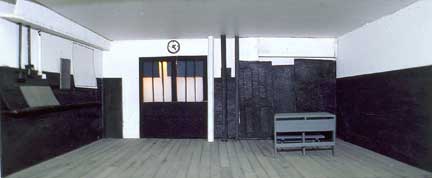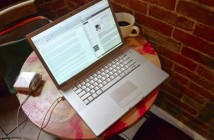What does it mean to understand the concept of place and how do we define it? Cultural essayist J. B. Jackson described the origin of the idea in our modern lexicon -- to define the specificity of place -- as a transformation of the Latin expression: genius loci. Referring initially to the supernatural guardian presiding over an area, the term transformed over time to mean a place's influence, its genius or the sense or feeling of that "place". We can look at a road atlas to find our way to a given destination, but it rarely competes with the language describing the peculiar details that comes experiencing in an area. With a map, what we have is a cat's cradle of information so that we may locate the space again if necessary. Geographically describing an area by its coordinates is helpful for finding one’s way to a given space, but it takes our active participation, our personal psychology, to transform space from transition into destination.
Attempting to describe this phenomenon further, Site Specific, the 23rd installment from Malden’s unique gallery, artSPACE@16, features the work the of Hillary Baldwin, Lior Neiger, Maria Raponi, Daniel Rich, and Lauren Warner, all from the School of the Museum of Fine Arts, Boston. This gathering of artwork, organized by guest curator Jonathan Santos, focuses on the complexities of the “psychological, physical, and cultural notion of location” and aims to, “not only examine the commonalities and contradictions of our concept of a place, but also to understand and define our position within the increasingly global community.”
How does this curatorial framing manifest itself in the artwork? For the most part, locations referenced in the artwork are often minimal in detail. Their subjects are often focused on one structure or attraction, giving us a focal point to identify a specific location. This reservation of detail, though, abstracts the space, restricting our fully apprehending the location as place. But, we as viewers immediately recognize it as place and make associations through remembering the subject without comprehending why. So how is this communication of place occurring, even if we have never experienced it? Every piece in this show addresses the representation concept of place through a variety of media, but what conjures up the unearned memory of experience, which gives the illusion of having acknowledged the presence of place? Site Specific does not include one photograph, but the underlying representational syntax of all the work is photographic.
For example, how many of us have come in contact with an igloo? The depiction of Baldwin’s Igloo is “(exists) in the mediated cultural memory” and is “excavated from the archives of the collective unconscious.” The silent documentary film, Robert Flaherty’s Nanook of the North was first seen by the public in 1922 and remains a primary source by which we stereotype Inuit culture. Warner’s painting, Yellowstone 2, depicts a location and a reoccurring event simultaneously whose every eruption is different. Being one of the most reproduced natural wonders in postcard form, every version is a new event though the identity remains the same. Equally flat and graphic is Rich’s rendering ofMassachusetts General Hospital, a modernist structure whose design is maximized on a space to utility ratio. The basis for this rendition relies on the flattening aspect of a reproduction into a schematized pattern, which turns out to be a perfect method for economizing the description of these structures. Studio sets are designed on the fact that the camera flattens and disguises seams in the woodwork. The dioramas by Raponi were transient places used as establishing backdrops to fictional action. Though the films referenced are fictional, like Amelie and 400 Blows, the experiences of performance of the crew on those sets were based in reality. The sets are roughly reconstructed in miniature from composites and establishing shots of specific scenes form the movies, whose flattening effect is undone by this second representation in sculpture. Neiger’s Globe does not index an actual place at all, only a diagram symbolizing invisible national borders whose accuracy is checked against satellite imaging. This spinning globe is rephotographed in video, animated on its axis, stopping in sync to a stereo image of another globe, symbolizing how the cropping create connections through graphic proximity.
The photographic illusion of space is our culture’s default system of representation with which we encode such descriptive information. Since the nineteenth century, the naturalizing description of photography, along with other industrialized means of transmission, allowed a greater diffusion of visual discription than previously known. With this mechanization of looking, no longer did people so earnestly need to be in the presence of what you wanted to see, you could look at the copy of it that seemed like the original. You could be satisfied with it, if you were willing to accept the copy as a willing substitute for the original.
These artworks have distanced and multiplied the original meaning of the place by copying its easily identified monument, and moving it to another location. The decidedly most important elements of these places subjectively copied, leaving the viewer one step removed from this recognition of place. The artists' works reestablish a personal link of remembrance to the individual place through subjective copying, referenced from some kind photographic source. The actual place referred is further distanced and we are left with the autographic residue of the artists' acts.
What we see as viewers is not the place, but the artists' struggle to conjure up the influence of place, using artwork to try to establish a link between place and the representation of that locale. What we might mistake for sense of place might actually be the aura of a forever distanced presence, never to be fully realized. These representations in Site Specific are now mobile objects that carry a translation of that location, and their meanings are diffused and multiplied.
It is that distancing from the original object, placed in another forum, which only allows us as viewers to imagine what that uniqueness of that location might be and how we might situatate ourselves within it. It is a sensation that can never be experienced, even if we visit those exact spots. Wherever in the world you go, the resolution of this desire will never be relieved without dissolving the original fixation for feeling you should be there in the first place.
_
Dear Walter Benjamin,
WISH YOU WERE HERE.
Some postcard!
Links:
artSPACE@16
"Site Specific" is on view until August 28th at artSPACE@16, located at 16 Princeton Rd., Malden.
All images are courtesy of the artists and artSPACE@16.
Matthew Gamber is the executive editor of Big, Red & Shiny.




